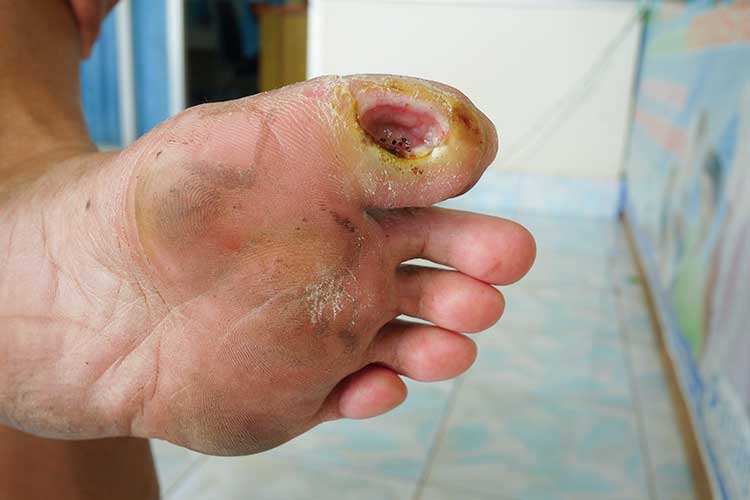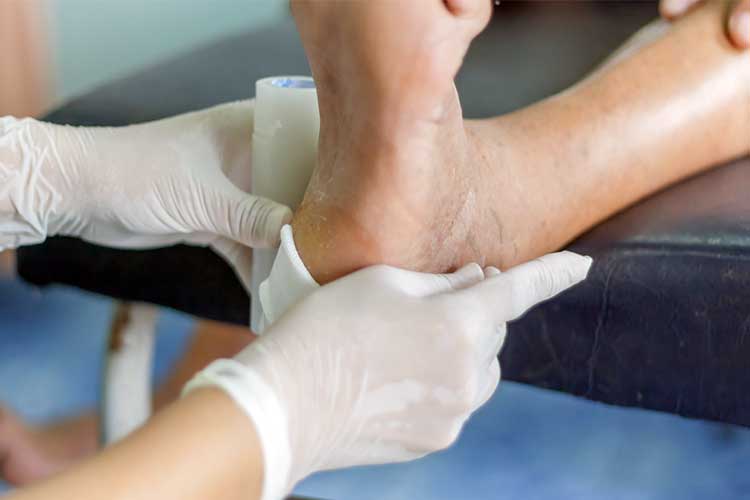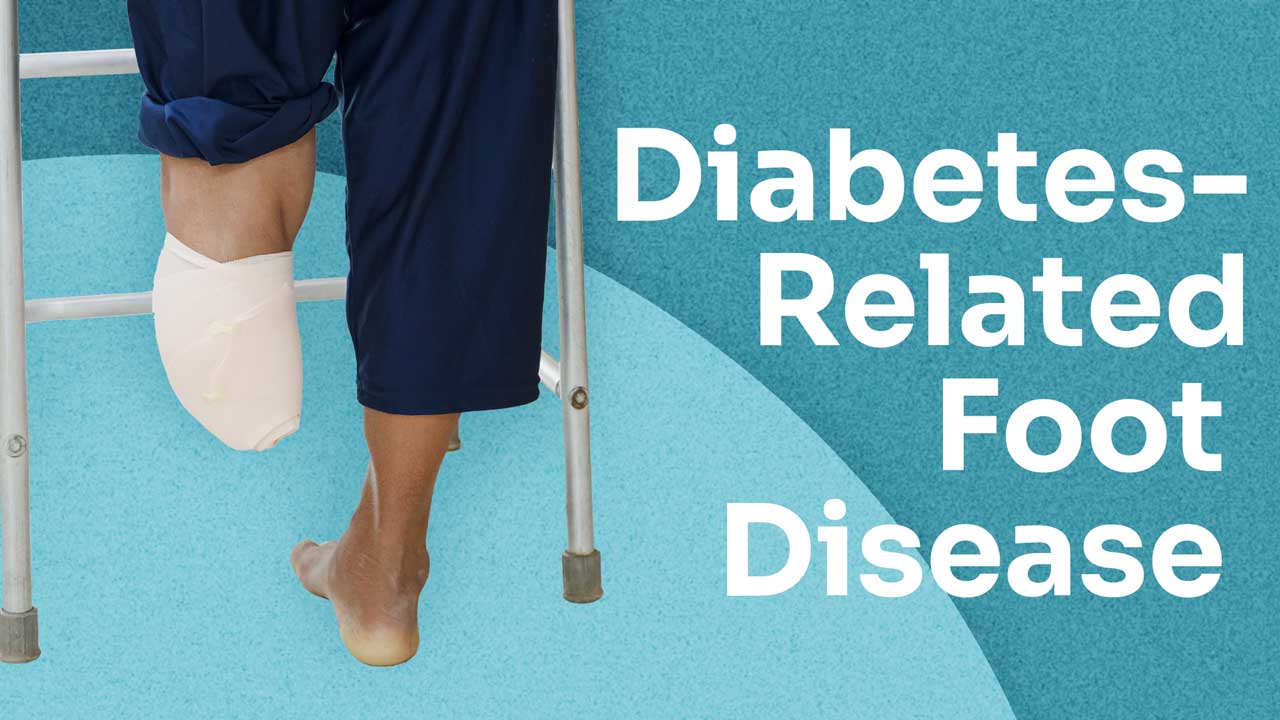What is Diabetes-Related Foot Disease?
Diabetes-related foot disease (DFD) describes complications of diabetes that affect the feet (Cleveland Clinic 2024).
High or fluctuating blood glucose levels caused by diabetes decrease blood flow to the extremities, and nerve damage will prevent the skin from repairing itself. The nerve damage caused by hyperglycaemia is known as diabetic neuropathy (Cleveland Clinic 2021).
DFD results in an insensitive and potentially deformed foot, sometimes causing an unusual manner of walking (DFA 2022).
DFD can occur in patients with both Type 1 and 2 diabetes (Packer et al. 2023).

Types of Diabetes-Related Foot Disease
Diabetic neuropathy can cause any skin, nerve or circulation issue in the feet to become infected or lead to complications. Conditions that could lead to complications include:
- Cuts, ulcers, burns and blisters
- Dry or cracked skin
- Corns and calluses
- Fungal infections
- Ingrown toenails
- Bunions and hammertoes.
(Cleveland Clinic 2024)
Diabetes-Related Foot Disease Complications
Due to the loss of sensation caused by diabetic neuropathy, a person is unlikely to notice if they have injured their foot and, furthermore, are unlikely to realise that their condition is worsening (Cleveland Clinic 2024).
The foot sores, cuts and ulcers incurred by the patient may become infected. These infections can potentially spread to the bone, and ulcers can lead to tissue death (Mayo Clinic 2022).
As a result of this, the amputation of a toe, foot or even the lower leg may be necessary (Mayo Clinic 2022).
Diabetes-Related Foot Disease in Numbers
Around 1,300,000 (1 in 20) Australians have diabetes (ABS 2022). Diabetes presents a considerable challenge to Australia’s healthcare system and is one of the fastest-growing chronic conditions in the country (Diabetes Australia 2024).
Over 4,400 amputations related to diabetes are performed every year in Australia, yet it’s believed that 85% of these amputations are avoidable if detected early and managed properly (Diabetes Australia 2023a)
The solution most often suggested to patients is a daily foot care routine and regular foot monitoring with the help of a healthcare professional (Diabetes Australia 2023b).
Diabetes-Related Foot Disease Treatment
In the majority of cases, foot ulcers will heal if the correct procedures are followed.
It’s worth noting that even the best wound care cannot compensate for ongoing damage to the wound bed, inadequately treated ischaemia or infection. Patients with a deep ulcer often require intensive treatment or may need to be admitted to the hospital (DFA 2022).
The following treatment strategies are recommended:
- Protecting the ulcer and relieving it from pressure
- Ensuring skin perfusion
- Treating infection
- Metabolic control and treatment of comorbidities
- Wound care
- Educating patients and relatives about foot care
- Taking preventative measures to avoid recurrence.
(DFA 2022)
When to Escalate Care

Patients should seek immediate medical attention if they notice any of the following signs:
- Ulcer
- Unusual swelling
- Redness
- Blisters
- Ingrown toenail(s)
- Bruising or cuts.
(Diabetes Australia 2023b)
Prompt medical attention (not necessarily immediately but still within a week’s time frame) is to be advised if patients notice:
- Broken skin between the toes
- A callus
- A corn
- Changes in foot shape
- Cracked skin
- Nail colour changes.
(Diabetes Australia 2023b)
Preventing Diabetes-Related Foot Disease
The following preventative measures are recommended to avoid the escalation of this condition:
- Assess all people with diabetes and determine their risk of developing foot complications
- Frequently inspect and examine the at-risk foot
- Educate the patient, family and healthcare providers
- Advise patients to wear appropriate footwear (well-fitting, protective and closed)
- Attend to pre-ulcerative signs
- Advise patients to perform daily foot care (washing and thoroughly drying feet, assessing for signs of infection, moisturising dry skin)
- Ensure the patient’s toenails are cut straight across and kept trimmed
- Ensure the patient checks the temperature of bath water with their elbow before they step into the bath.
(DFA 2022; Diabetes Australia 2023b; Better Health Channel 2023)
The Impacts of Diabetes-Related Foot Disease on Health
A study conducted by the University of Wollongong in 2018 found that people with DFD ulcers tended to have an overall low quality of life, especially those with larger ulcers, chronic ulcers and ulcers complicated by infection (Khunkaew et al. 2019).
Researchers collected data from 12 studies on health-related quality of life in people with DFD and found that patients had poorer physical functioning, vitality and overall quality of life than those without DFD (Khunkaew et al. 2019).
Conclusion
The severity of DFD should not be underestimated. As the prevalence of diabetes continues, DFD will remain a prominent health issue.
Diabetes-related foot ulcers are globally recognised as the primary cause of diabetes-related hospitalisations and amputation, with mortality rates comparable to those of many cancers (DFA 2022).
Education and prevention are vital to improving the quality of life in people with diabetes and to curbing high rates of avoidable amputations.
Test Your Knowledge
Question 1 of 3
True or false: Most diabetes-related amputations are avoidable.
Topics
References
- Australian Bureau of Statistics 2022, Diabetes, Australian Government, viewed 5 July 2024, https://www.abs.gov.au/statistics/health/health-conditions-and-risks/diabetes/latest-release
- Better Health Channel 2023, Diabetes - Foot Care, Victoria State Government, viewed 5 July 2024, https://www.betterhealth.vic.gov.au/health/conditionsandtreatments/diabetes-foot-care
- Cleveland Clinic 2024, Diabetes-Related Foot Conditions, Cleveland Clinic, viewed 5 July 2024, https://my.clevelandclinic.org/health/diseases/21510-diabetic-feet
- Cleveland Clinic 2021, Diabetes-Related Neuropathy, Cleveland Clinic, viewed 5 July 2024, https://my.clevelandclinic.org/health/diseases/21621-diabetic-neuropathy
- Diabetes Australia 2023a, 4400 Reasons to End Amputations, Diabetes Australia, viewed 5 July 2024, https://www.diabetesaustralia.com.au/wp-content/uploads/4400-facts-and-figures.pdf
- Diabetes Australia 2023b, Diabetes and Your Feet, Diabetes Australia, viewed 5 July 2024, https://www.diabetesaustralia.com.au/living-with-diabetes/preventing-complications/foot-care/
- Diabetes Australia 2024, Diabetes in Australia, Diabetes Australia, viewed 5 July 2024, https://www.diabetesaustralia.com.au/about-diabetes/diabetes-in-australia/
- Diabetes Feet Australia 2022, For Health Professionals, Diabetic Feet Australia, viewed 5 July 2024, https://www.diabetesfeetaustralia.org/for-health-professionals/
- Diabetic Feet Australia 2020b, For Patients, Diabetic Feet Australia, viewed 4 July 2022, https://www.diabeticfootaustralia.org/for-patients/
- Khunkaew, S, Fernandez, RS & Sim, J 2019, ‘Health-Related Quality of Life Among Adults Living with Diabetic Foot Ulcers: A Meta-Analysis’, Quality of Life Research, vol. 28, no. 6, viewed 5 July 2024, https://core.ac.uk/download/pdf/212722647.pdf
- Mayo Clinic 2022, Amputation and Diabetes: How to Protect Your Feet, Mayo Clinic, viewed 5 July 2024, https://www.mayoclinic.org/diseases-conditions/diabetes/in-depth/amputation-and-diabetes/art-20048262
- MedlinePlus 2024, Diabetic Foot, U.S. Department of Health and Human Services, viewed 3 July 2024, https://medlineplus.gov/diabeticfoot.html
- Packer, CF, Ali, SA & Manna, B 2023, ‘Diabetic Ulcer’, StatPearls, viewed 5 July 2022, https://www.ncbi.nlm.nih.gov/books/NBK499887/
 New
New 
